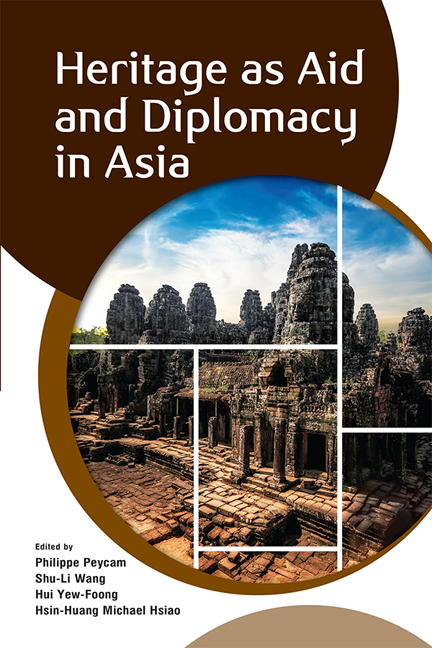Book contents
- Frontmatter
- Contents
- Contributors
- 1 Heritage as Aid and Diplomacy in Asia: An Introduction
- 2 World Heritage and WikiLeaks: Territory, Trade and Temples on the Thai-Cambodian Border
- 3 Heritage Making – Aid For Whom? The Genealogy of Expert Reports in the Hands of Politics and Their Impact in the Case of Preah Vihear
- 4 The International Coordinating Committee for Angkor: A World Heritage Site as an Arena of Competition, Connivance and State(s) Legitimation
- 5 Legacies of Cultural Philanthropy in Asia
- 6 To Help or Make Chaos? An Ethnography of Dutch Expertise in Postcolonial Indonesia
- 7 Heritage Conservation as a Tool for Cultural Diplomacy: Implications for the Sino-Japanese Relationship
- 8 From Ideological Alliance to Identity Clash: The Historical Origin of the Sino-Korean Goguryeo Controversies
- 9 Nationalism, Politics and the Practice of Archaeology in Afghanistan: A Case Study of Bamiyan
- 10 Disappearing Voices: The Politics and Practice of Safeguarding Kunqu Opera in the People’s Republic of China
- 11 Neoliberalizing Heritage: International Agencies and the Local Dynamics of Heritage Conservation in Bali, Indonesia
- 12 Heritage Conservation as Trickle-Down Development
- Index
6 - To Help or Make Chaos? An Ethnography of Dutch Expertise in Postcolonial Indonesia
Published online by Cambridge University Press: 10 November 2020
- Frontmatter
- Contents
- Contributors
- 1 Heritage as Aid and Diplomacy in Asia: An Introduction
- 2 World Heritage and WikiLeaks: Territory, Trade and Temples on the Thai-Cambodian Border
- 3 Heritage Making – Aid For Whom? The Genealogy of Expert Reports in the Hands of Politics and Their Impact in the Case of Preah Vihear
- 4 The International Coordinating Committee for Angkor: A World Heritage Site as an Arena of Competition, Connivance and State(s) Legitimation
- 5 Legacies of Cultural Philanthropy in Asia
- 6 To Help or Make Chaos? An Ethnography of Dutch Expertise in Postcolonial Indonesia
- 7 Heritage Conservation as a Tool for Cultural Diplomacy: Implications for the Sino-Japanese Relationship
- 8 From Ideological Alliance to Identity Clash: The Historical Origin of the Sino-Korean Goguryeo Controversies
- 9 Nationalism, Politics and the Practice of Archaeology in Afghanistan: A Case Study of Bamiyan
- 10 Disappearing Voices: The Politics and Practice of Safeguarding Kunqu Opera in the People’s Republic of China
- 11 Neoliberalizing Heritage: International Agencies and the Local Dynamics of Heritage Conservation in Bali, Indonesia
- 12 Heritage Conservation as Trickle-Down Development
- Index
Summary
Draped over the curve of coastal hills as they give way to a sweltering plain that borders the Java Sea is the Indonesian city of Semarang. Now a moderately-sized provincial capital of 1.5 million people, Semarang was once a rival to its better-known neighbour, Batavia (now Jakarta), and for centuries boasted substantial wealth and political influence on par with some of Southeast Asia's most prominent port cities. Javanese, Chinese, Malay, South Asian and Arab communities first made their homes here, drawn to the vast network of lucrative trade routes that threaded through the city and its bustling harbour (Muhammad 2011). Then, from the late seventeenth to the mid twentieth century, waves of Dutch colonizers arrived on these shores, transforming Semarang into a foothold of their empire in the archipelago and a “gateway to modernity” for the whole of central Java (Coté 2006; Cobban 1988). In the decades leading up to World War II, Semarang gained further fame as a hotbed of radical politics and local resistance to foreign rule, earning it the moniker Kota Merah, or “The Red City”, in reference to its association with early leftist leaders in the anti-colonial struggle (Poeze 2014). Now, over seventy years since Indonesia declared its independence, this deep history of colonialism, cosmopolitanism and conflict is etched upon the contemporary cityscape, which still bears tangible traces of this tumultuous past in the form of mosques and temples, marketplaces and railways, dwellings and warehouses, barracks and offices, lighthouses and canals.
Semarangers today regard many of these crumbling structures as sites of memory and meaning, whether for themselves, their families or their own ethnic and religious communities. However, one site in particular has drawn significant attention from government authorities, civil society groups and community organizations in recent years: Kota Lama, or “The Old Town”. Strategically nestled between the city's historic port and the densely packed districts of Pecinan (Chinatown), Kauman (the Arab and Javanese quarter), Kampung Melayu (the Malay quarter) and Pekojan (the South Asian quarter), Kota Lama consists of a cluster of streets and buildings that once lay within the walls of a fortress built in the mid 1700s by the Dutch East India Company (VOC) as a base from which to extend control over the city.
- Type
- Chapter
- Information
- Heritage as Aid and Diplomacy in Asia , pp. 143 - 166Publisher: ISEAS–Yusof Ishak InstitutePrint publication year: 2020



